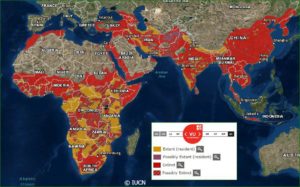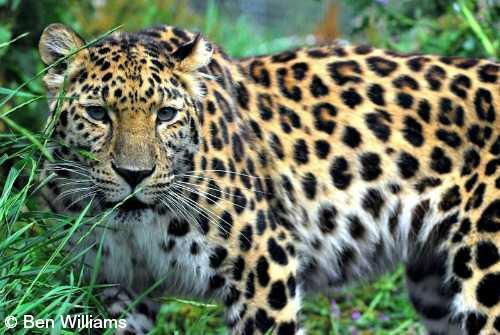
- HB Length: 91-191 cm (35-75″)
- Tail Length: 51-101 cm (20-40″)
- Height: 43 – 76 cm (17 – 30.5″)
- Weight: 17-90 kg (37-198 lbs)
- Pop. Trend: Decreasing
Leopards Panthera pardus are the most widespread and adaptable big cat, and are found in almost every habitat, from desert to rainforest. Because of this wide distribution, Leopards exhibit extreme variability in coat colour, ranging from greyish or pale yellow to a rich buff or chestnut colour. There are black spots on the head, lower limbs and tail, and black spots that form rosettes on the back, flanks, and upper limbs of the sleek, athletic body. The underside of the body is whitish in colour. Coat colour and patterning are broadly associated with habitat type. In captivity, the Leopard is often confused with the Jaguar Panthera onca of Central and South America, but is relatively smaller and slimmer, with a longer tail and smaller head. Melanistic Leopards called ‘black panthers’ are fairly common, especially in moist, dense forests like those of Bengal and Java.
The head is relatively small and convex in profile. The irises are yellow, green or grey, and the pupils are round. The ears are rounded, backed with black, and have conspicuous white central spots. The legs are rather short and stout. Their long tail is patterned with spots and rosettes, and black tipped. The underside is white, and along with the white spots on the backs of the ears, is thought to be conspicuous ‘follow me’ signs for the cubs following the female through dense vegetation.
Distribution

Leopards are widely distributed in sub-Saharan Africa, but populations have been reduced in western and northern Africa. There is a relic population in the Middle East, and Russia. Populations have also been reduced throughout Asia, but still range from India and China south through the Malay peninsula to the islands of Borneo, Sumatra, and Java.
They are equally at home in a steaming Indian jungle, a cool Amur forest, or the hot, treeless mountains of Iran and Afghanistan. A very wide habitat tolerance means they range from boreal forests with winter temperatures of -30°C to arid deserts reaching summer temperatures of +70°C. Requiring some vegetative or natural cover, Leopards are absent from open desert interiors but can be found along watercourses and rocky areas.
Due to their large distribution, Leopard home ranges vary from 5.6 km2 in Kenya to 2,750 km2 in the Kalahari. Ranges are larger in arid habitats where fewer prey species are available. One collared male in rocky arid habitat in central Iran used 626 km2 in 10 months. Two studies in Thailand found home ranges to be 8.8 -17 km2 for females and 17 – 37 km2 for males.
A well studied cat, Leopard densities have been found to range from 1-4 cats per 100 km2 in the Russian boreal forest to 16 per 100 km2 in Kruger National Park, South Africa.
Ecology
Solitary and territorial, adults defend a core area of their home range, although they are tolerate of overlapping at the edges, using mutual avoidance and alternating use of the land.
Leopards are quite athletic, being very strong climbers and good swimmers when necessary. Active between dusk and dawn, Leopards will also hunt during the day in marginal habitat or in areas where they are not persecuted by man. They usually rest up in trees during the heat of the day, but may also lay in dense vegetation or among rocks.
Hunting is accomplished mainly by stalking, stealthily approaching their prey as close 4-5 m before making a final explosive rush.
Their diet is extremely varied and consists of anything available, from dung beetles to adult antelope to carrion. Over 90 species have been recorded in their diet in Africa. They are known for preying on domestic stock, occasionally entering corrals and settlements, and readily take domestic dogs. Leopards often store carcasses in the forked branches of trees, dragging prey more than two or three times their own body weight out of the reach of other carnivores.
Reproduction
Breeding can occur throughout the year in Africa and India, but is mainly confined to January and February in China and southern Siberia. The oestrous cycle averages about 46 days, and heat lasts for six or seven days. Males and females are known to form hunting pairs during the mating season, and may even stay together for a short period of time after mating. One to four, usually two or three, cubs are born in a cave, rock crevice, or hollow tree after a gestation period of 90 – 105 days. They weigh between 400 and 700 grams at birth, and are covered with dark, woolly fur peppered with indistinct spotting. Their eyes open between seven and ten days, and they begin to walk around two weeks of age. Weaned at three or four months, the young separate from their mother between 18 – 24 months. Females reach sexual maturity at an average of 33 months, while males take 24 – 36 months. Captive Leopards have lived up to 23 years.
Conservation
Leopards have fared slightly better than other big cats, due mainly to their wide distribution and amazing adaptability. Although they are amazingly tolerant of human activity and persist where other carnivores cannot, they have been extirpated from approximately 37% of their African range. Populations in North Africa, the Middle East and Russia are now Critically Endangered.
Loss of habitat and prey, as well as intense persecution as livestock killers, is the chief threat to this magnificent big cat. They are heavily hunted in southern Asia for their skin and bones supplying the Chinese medicinal trade. In western and central Africa, they are hunted for their skins, teeth and claws. In tropical forests, bushmeat hunting competes directly for prey species and may drive them to extinction even in forests that have not been logged.
Range Map IUCN Red List 2008
Updated 2016

Arthur Mixon
Hello Pat,
I would just like to mention that in the description of the asiatic leopard it is mentioned that its tolerance of extreme heat allows it to exist at temps up to 70 deg C. That is equivalent to 158 deg F. The highest temp ever measured on planet Earth was 134 deg F or 57 deg C so you might want to reconsider that value. Thanks for all the information about wild cats in general – very well done.